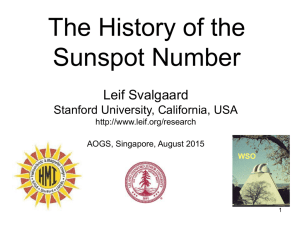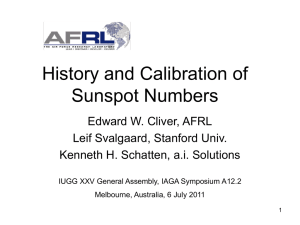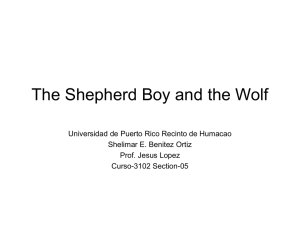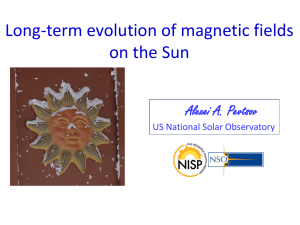Solar-Activity-Past-Present-and-Future
advertisement
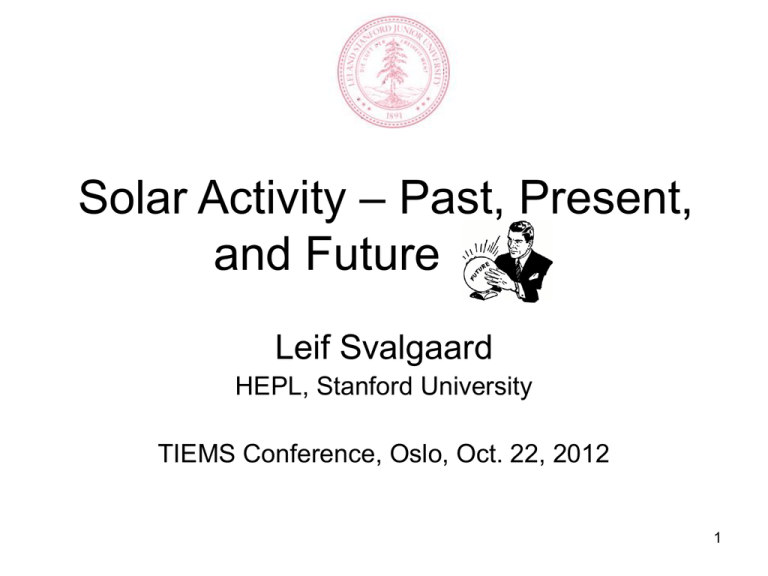
Solar Activity – Past, Present, and Futuremmm Leif Svalgaard HEPL, Stanford University TIEMS Conference, Oslo, Oct. 22, 2012 1 Indicators of Solar Activity • Sunspot Number (and Area, Magnetic Flux) • Solar Radiation (TSI, UV, …, F10.7) • Cosmic Ray Modulation • Solar Wind • Geomagnetic Variations • Aurorae • Ionospheric Parameters • Oscillations • Climate? • More… Longest direct observations Penumbra Umbra After Eddy, 1976 Solar Activity is Magnetic Activity 2 The Sunspot Number(s) • Wolf Number = KW (10*G + S) • G = number of groups • S = number of spots • Group Number = 12 KG G Douglas Hoyt and Kenneth Schatten devised the Group Sunspot Number using just the group count (1993). Unfortunately a K-factor was also necessary here, so the result really depends on how well the K-factor can be determined Rudolf Wolf (1816-1893) Observed 1849-1893 Ken Schatten 3 The Wolf Number, Zürich Sunspot Number, and International Sunspot Number are all synonyms for the same data, today maintained by the Solar Influences Data Center, SIDC, in Brussels, Belgium Problem with The ‘Wolf’ Number The effect of Weighting the sunspot count… Zürich Observers Wolf Wolfer Brunner Waldmeier 1849-1893 1876-1928 1929-1944 1945-1995 4 Waldmeier’s Description of the Weighting of Sunspots that began in the 1940s Zürich Locarno 1968 “A spot like a fine point is counted as one spot; a larger spot, but still without penumbra, gets the statistical weight 2, a smallish spot with penumbra gets 3, and a larger one gets 5.” Presumably there would be spots with weight 4, too. This very important piece of metadata was strongly downplayed and is not generally known 5 Locarno, a week later No Weight 2 4 4 6 2 4 2 2 1 2 1 SDO AIA 450nm SDO HMI LOS Combined Effect of Weighting and More Groups is an Inflation of the Relative Sunspot Number by 20+% I have re-counted 43,000 spots without weighting for the last ten years of Locarno observations. 30 Groups ‘Spots’ 10*11+52=162; 10*11+30=140; 162/140=1.16 6 Double-Blind Test of My Re-Count I proposed to the Locarno observers that they should also supply a raw count without weighting Marco Cagnotti For typical number of spots the weighting increases the ‘count’ of the spots by 3050% (44% on average) 7 Comparison Zurich Sunspot Number and That Derived from Sunspot Areas 300 1000 Monthly Means Rz Rz Rz 250 100 Rc = 0.3244*SA0.732 10 200 1 0.1 1 10 100 1000 10000 SA SA 0.1 150 100 50 0 1875 1880 1885 1890 1895 1900 1905 1910 1915 1920 1925 1930 1935 1940 1945 Comparison Zurich Sunspot Number and That Derived from Sunspot Areas 300 0.732 RZ /SA >1000 uH Monthly Means 0.7 Rz 250 (projected) 0.8 Monthly Means 0.6 0.5 0.732 Rc = 0.3244*SA 0.4 0.3 0.2 200 0.1 Wolfer Brunner Waldmeier SIDC 0 1870 1880 1890 1900 1910 1920 1930 1940 1950 1960 1970 1980 1990 2000 150 100 50 0 1945 1950 1955 1960 1965 1970 1975 1980 1985 1990 1995 The 20% Inflation Caused by Weighting Spot Counts 2000 8 Correcting for the 20% Inflation Sunspot Number (Official SIDC View) 200 180 Rcorr = Rofficial * 1.2 before ~1946 160 140 120 100 80 60 40 20 0 1700 1725 1750 1775 1800 1825 1850 1875 1900 1925 1950 1975 2000 This issue is so important that the official agencies responsible for producing sunspot number series have instituted a series of now ongoing Workshops to, if at all possible, converge to an agreed upon, common, corrected series: http://ssnworkshop.wikia.com/wiki/Home The inflation due to weighting is now an established and accepted fact Modern Grand Max? GSN That the corrected sunspot number is so very different from the Group Sunspot Number is a problem for assessing past solar activity and for predicting future activity. This problem must be resolved. 9 Problem with the Group Sunspot Number Determining correct K-factors… 10 The Ratio between the Group Sunspot Number and the [corrected] Sunspot number Shows that the significant discrepancy is largely due to data from the 1880s 11 Wolf-Wolfer Groups Number of Groups: Wolfer vs. Wolf 9 Wolfer 8 Yearly Means 1876-1893 7 6 Wolfer = 1.653±0.047 Wolf 5 R2 = 0.9868 Wolfer 4 3 2 80mm 64X 1 Wolf 0 0.0 0.5 1.0 1.5 2.0 2.5 3.0 3.5 4.0 4.5 5.0 Number of Groups 12 10 Wolf*1.653 8 Wolfer Wolf 6 4 Wolf 37mm 20X 2 0 1865 1870 1875 1880 1885 1890 1895 12 Why are these so different? Observer This is the main reason for the discrepancy K-Factors H&S RGO to Wolfer Begin K-factors End 1.8 Wolfer, A., Zurich 2% diff. Wolf, R., Zurich Schmidt, Athens Weber, Peckeloh Spoerer, G., Anclam Tacchini, Rome Moncalieri Leppig, Leibzig Bernaerts, G. L., England Dawson, W. M., Spiceland, Ind. Ricco, Palermo Winkler, Jena Merino, Madrid Konkoly, Ogylla Quimby, Philadelphia Catania Broger, M, Zurich Woinoff, Moscow Guillaume, Lyon Mt Holyoke College 1.094 1.117 1.135 0.978 1.094 1.059 1.227 1.111 1.027 1.01 0.896 1.148 0.997 1.604 1.44 1.248 1.21 1.39 1.251 1.603 1 1.6532 1.3129 1.5103 1.4163 1.1756 1.5113 1.2644 0.9115 1.1405 0.9541 1.3112 0.9883 1.5608 1.2844 1.1132 1.0163 1.123 1.042 1.2952 1876 1876 1876 1876 1876 1876 1876 1876 1876 1879 1880 1882 1883 1885 1889 1893 1897 1898 1902 1907 1928 1893 1883 1883 1893 1900 1893 1881 1878 1890 1892 1910 1896 1905 1921 1918 1928 1919 1925 1925 This analysis 1.6 1.4 1.2 1 H&S 0.8 0.8 1 1.2 1.4 1.6 1.8 2 Zürich Classification: a b ½ of all groups Wolf couldn’t see most a & b groups with his small telescope A still unresolved question is how Hoyt & Schatten got the K-factors so wrong 13 Comparing G. Spörer & Rev. A. Quimby [Philadelphia] to Wolfer Number of Groups 14 12 Spörer*1.416 10 8 6 Wolfer 4 Spörer 2 0 1860 Same good and stable fit, showing that Wolfer’s count had not drifted with time 12 1865 1870 1875 1880 1885 1890 1895 1900 1905 10 Tacchini * 1.176 8 Number of Groups 9 6 Wolfer 4 8 Tacchini Quimby*1.284 2 7 0 1865 6 1870 1875 1880 1885 1890 1895 1900 1905 1910 Wolfer 9 5 8 7 4 6 Wolfer Moncalieri * 1.511 5 3 4 Quimby 2 3 Moncalieri 2 1 0 1885 1 0 1870 1890 1895 1900 1905 1910 1915 1920 1925 1875 1880 1885 1890 1895 14 1900 Constructing a Composite Comparing 22 observers that overlap with each other one can construct a composite group number successively back to Schwabe and up to Brunner: Comparison Composite Groups and Scaled Zurich SSN 14 Composite Zurich 12 10 8 6 4 2 0 1820 1830 1840 1850 1860 1870 1880 1890 1900 1910 1920 1930 1940 There is now no systematic difference between the Zürich SSN and a Group SSN reconstructed here by using correct K-factors relative to Wolfer. 15 Geomagnetic Calibration of Sunspot Numbers Wolf did it… 16 Geomagnetic Regimes 1) Solar UV maintains the ionosphere and influences the daytime field. 2) Solar Wind creates the magnetospheric tail and influences mainly the nighttime field 17 Wolf’s Discovery: rD = a + b RW . North X rY Morning H rD Evening D East Y Y = H sin(D) dY = H cos(D) dD For small D, dD and dH A current system in the ionosphere [E-layer] is created and maintained by solar FUV radiation. Its magnetic effect is measured on the ground. (George Graham, 1722) 18 The Diurnal Variation of the Declination for Low, Medium, and High Solar Activity 8 6 9 10 Diurnal Variation of Declination at Praha (Pruhonice) dD' 4 1957-1959 1964-1965 2 0 -2 -4 -6 -8 -10 Jan Feb Mar Apr Jun Jul Aug Sep Oct Nov Dec Year Diurnal Variation of Declination at Praha 8 6 May dD' 1840-1849 rD 4 2 0 -2 -4 -6 -8 -10 Jan Feb Mar Apr May Jun Jul Aug Sep Oct Nov Dec Year 19 Wolf got Declination Ranges for Milan from Schiaparelli and it became clear that the pre-1849 SSNs were too low Justification for Adjustment to 1861 1874 List 160 R Wolf 140 '1874 List' 1836-1873 120 Wolf = 1.23 Schwabe 100 '1861 List' 1849-1860 Wolf 80 60 '1861 List' 1836-1848 Schwabe 40 20 rD' Milan 0 4 5 6 7 8 9 10 11 12 13 The values for 1836-1848 came from Schwabe. Wolf decided to increase them by 25% to match his own relationship with Milan’s Declination The smallest non-zero SSN should be 11. When it is not, it indicates adjustments were made The ‘1874’ list included the 25% [Wolf said 1/4] increase of the pre-1849 SSN. Was this a sensible thing to do? 20 Wolf’s Original Geomagnetic Data Wolf and Wolfer's Diurnal Ranges of Declination for their Long-running Stations 14 dD' 12 10 8 6 4 Praha (Prague) - Christiania (Oslo) - Milano (Milan) - Wien (Vienna) 2 0 1835 1840 1845 1850 1855 1860 1865 1870 1875 1880 1885 1890 1895 1900 1905 1910 1915 1920 1925 Diurnal Range Compared to Scaled International Sunspot Number 70 RI* 60 rY (nT) 50 40 30 20 10 Today we know that the relevant parameter is the East Component, Y, rather than the Declination, D. Converting D to Y restores the stable correlation, especially around the critical time near 1885 where the GSN begins to deviate 0 1835 1840 1845 1850 1855 1860 1865 1870 1875 1880 1885 1890 1895 1900 1905 1910 1915 1920 1925 Wolf found a very strong correlation between his Wolf number and the daily range of the Declination. Wolfer found the original correlation was not stable, but was drifting with time and gave up on it in 1923. 21 Using rY from nine station ‘chains’ we find that the 300 F10.7 250 y = 5.4187x - 129.93 R2 = 0.9815 200 correlation 150 Canonical Relationship SSN and F10.7 250 1952-1990 F10.7 200 100 y = 0.043085x 2.060402 R2 = 0.975948 150 100 50 y = -0.0000114x 3 + 0.0038145x 2 + 0.5439367x + 63.6304010 R2 = 0.9931340 50 SSN rY 0 0 20 40 60 80 100 120 140 160 180 200 0 30 35 40 45 50 55 60 nT 70 65 between F10.7 and rY is extremely good (more than 98% of the variation is accounted for) Solar Activity From Diurnal Variation of Geomagnetic East Component 250 200 Nine Station Chains F10.7 sfu F10.7 calc = 5.42 rY - 130 150 100 12 13 14 15 16 17 18 19 20 21 22 23 1980 1990 2000 50 25+Residuals 0 1880 1890 1900 1910 1920 1930 1940 1950 1960 1970 2010 This establishes that Wolf’s procedure and calibration are physically sound, and that the diurnal variation gives us a method for calibration of the SSN 2020 22 Solar Wind in the Past The Geomagnetic Record Allows us to Reconstruct the Solar Wind Properties for the Past 180 years 23 24-hour running means of the Horizontal Component of the low- & midlatitude geomagnetic field remove most of local time effects and leaves a Global imprint of the Ring Current [Van Allen Belts]: A quantitative measure of the effect can be formed as a series of the unsigned differences between consecutive days: The InterDiurnal Variability, IDV-index. 24 Similar to Bartels’ u-index and the ‘Nachstörung’ popular a century ago. IDV is strongly correlated with solar wind magnetic field B, but is blind to solar wind speed V nT 10 10 So, from IDV we can get HMF B B obs 8 8 B calc from IDV 6 6 B obs median 4 4 B std.dev 2 2 100% => 18 Coverage 0 0 1960 1965 1970 1975 1980 1985 1990 1995 2000 2005 2010 16 IDV vs. Solar Wind Speed V (1963-2010) IDV 14 HMF B as a Function of IDV09 10 B nT 12 1963-2010 10 8 8 6 6 4 2 4 y = 1.4771x0.6444 2 R = 0.8898 y = 0.4077x + 2.3957 2 R = 0.8637 4 10 0 0 2 6 8 12 14 2 R = 0.0918 2 V km/s IDV 16 0 350 400 450 500 550 25 The IHV Index gives us BV2 Calculating the variation (sum of unsigned differences from one hour to the next) of the field during the night hours [red boxes] from simple hourly means (the Interhourly Variation) gives us a quantity that correlates with BV2 in the solar wind 26 Physical meaning of IHV: the index is directly proportional to the auroral power input, HP, to the polar regions POES 27 Polar Cap Diurnal Variation gives us V times B E=-VxB This variation has been known for more than 125 years 28 Overdetermined System: 3 Eqs, 2 Unknowns B = p (IDV) BV2 = q (IHV) Gjøa VB = r (PCap) Here is B back to the 1830s: Heliospheric Magnetic Field at Earth 10 9 B 8 7 6 5 4 3 HMF from IDV-index 2 HMF observed in Space 1 0 1830 1840 1860 1870 1880 1890 1900 1910 1920 1930 1940 Cosmic Ray Modulation Parameter 1400 ϕ 1200 1850 1950 1960 1970 1980 1990 2000 2010 29 The Cosmic Ray Record has Promise, but is not without Problems 17 pounds/yr 2 oz/year Steinhilber et al. 2012 30 Cosmic Ray Modulation as Governed by Strength of Magnetic Field in Heliosphere Heliospheric Magnetic Field at Earth 10 B 9 8 7 6 5 4 3 HMF Observed in Space HMF deduced from Geomagnetic Record 2 1 0 1830 1840 1850 1860 1870 1880 1890 1900 1910 1920 1930 1940 1950 1960 1970 1980 1990 2000 2010 Cosmic Ray Modulation Parameter 1400 ϕ Problem 1200 Observed Modulation 1000 800 600 400 200 0 1830 HMF scaled to Neutron Monitor Modulation 1840 1850 1860 1870 1880 1890 1900 1910 1920 1930 Ion 1940 Neutron 1950 1960 1970 1980 1990 2000 201031 31 Total Solar Irradiance at 1 AU Predictions of SC24 Prediction of Solar Cycles North - South Solar Polar fields [microTesla] We are here now State of the Art From NOAA-NASA Panel 400 WSO MSO* 300 200 100 0 1965 -100 1970 1975 1980 1985 1990 1995 2000 2005 2010 2015 -200 Polar Field Reversal at Solar Maximum -300 -400 Solar Dipole Divided by Sunspot Number for Following Maximum 4.0 3.5 3.0 Polar Field Precursor Method WSO R24 2.5 45 2.0 1.5 20 21 22 23 24 72 1.0 Min 0.5 0.0 1965 1970 1975 1980 1985 1990 1995 165 2000 2005 2010 2015 32 How is Cycle 24 Evolving? As Predicted! 2016 5002016 4502016 4002016 3502016 3002016 2016 250 2017 200 2017 150 2017 100 2017 50 21 2017 0 2017 1980 2017 2017 6 7 8 9 10 11 12 1 2 3 4 5 6 19857 8 2016.458 Active Region Count 2016.542 2016.625 Numbered Active Regions per Month 2016.708 2016.792 2016.875 Prediction 2016.958 2017.042 2017.125 2017.208 2017.292 22 23 24 2017.375 2017.458 1990 1995 2000 2005 2010 2015 2020 2017.542 2017.625 D. Hathaway 300 250 200 150 100 22 14 21 50 0 1983 24 1984 1985 1986 1987 1988 1989 1990 SIDC 33 Observed Sunspot Number Divided by Synthetic SSN (1952-1990) 1.4 600 SIDC 1.2 R>10 500 0.655 SWPC 1.0 400 0.8 250 SSN 1952-1990 200 y = 0.000017x3 - 0.008270x2 + 2.367415x - 119.487222 R2 = 0.993433 150 0.6 ? 100 1996-2012 300 R Something is happening with the Sun 50 200 F10.7 0 0.4 0 50 100 150 200 250 Observed Sunspot Number Divided by Synthetic SSN (1952-1990) 1.4 Spots per Group for Locarno 600 SIDC 1.2 0.2 0.0 R>10 R 14 500 0.655 SWPC 1.0 100 400 0.8 0.6 19 ? 0.2 R 20 100 21 22 1975 1980 1985 1990 23 S/G 21 22 23 10 24 24 0 1950 1955 1960 1965 1970 1975 1980 1985 1990 1995 2000 2005 2010 2015 0.0 1950 1955 19 1960 1965 20 1970 12 300 R 200 0.4 (b) 8 0 1995 2000 2005 2010 2015 ? 6 4 Spots per Group declining SSN obs / SSN* 3.0 1975 1980 1985 1990 1995 2000 2005 2010 2 0 2015 SSN* = 54.7 MPSI 1.0089 2.5 2.0 5-month running average Magnetic Plage Strength Index Umbral Magnetic Field 4000 3500 Livingston & Penn B Gauss 3000 1.5 2500 1.0 2000 0.5 ? Year 0.0 1983 1985 1987 1989 1991 1993 1995 1997 1999 2001 2003 2005 2007 2009 2011 2013 2015 ? 1500 1000 1998 No visible spots form 2000 2002 2004 2006 2008 2010 2012 Year We don’t know what causes this, but sunspots are becoming more difficult to see or not forming as they used to. There is speculation that this may be what a Maunder-type minimum looks like: magnetic fields still present [cosmic rays still modulated], but just not forming spots. If so, exciting times are ahead. 34 Perhaps like this: Magnetic Field Visible Light 2012-10-17 35 Conclusions • The historical (official) ‘Wolf’ sunspot record has been re-assessed and need revision • The Group Sunspot Number is flawed and should not be used anymore • There likely was no Modern Grand Maximum • The Cosmic Ray record calibration is uncertain • The polar field precursor method for prediction of a low solar cycle 24 has worked well • The Sun may be entering a new regime of very low activity 36
